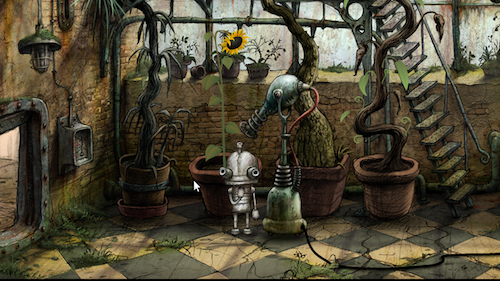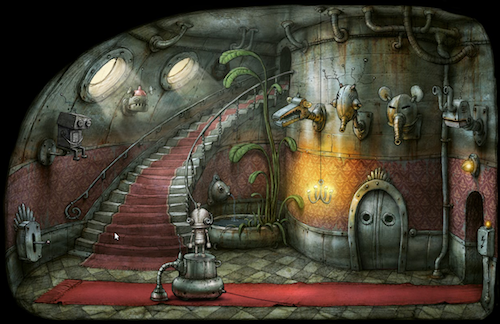
You’ll quickly fall in love with Machinarium. The graphics and animations are quirky, clever and alive, in a beautifully detailed retro-style that draws on many sources, but is reminiscent of The Triplets of Belleville, Sylvain Chomet’s 2003 animated masterpiece.
The hero of the game is a robot, newly ejected from his industrial steampunk-style robot city. You find him on a rubbish dump, and need to figure out how to fix him so he can return to the towering city of iron, oil and rust, to set matters aright.
On his journey, our nerdy little robot encounters one tricky obstacle after another, which he must solve using his extensible but limited body. Reminiscent of the old Sierra quest games, each location is “solved” by collecting and combining items, putting them to unexpected uses, or solving challenging (but not fiendish) in-game puzzles and sub-games. Why robots make their switches so complicated, only cog-brains would now, but the puzzles are ingenious and often humorous. Many of the in-game diversions pay homage to computer or arcade game classics.
Throughout the game, the characters and 2D environment are enchanting. The thugs are amusing caricatures, and the various robots you meet along the way are all full of funny quirks and imaginative personality. The prisoner whose only wish is a smoke, the burly guard who is all cut up because his pet’s batteries are dying, the devout acolyte of infinity, the lady in pink who lost her robot puppy, and the foot-stomping industrial-jazz band are each rendered with charm and humour.
The set is a magnificent hand-drawn world in the muted colours of a comfortable dystopia, and each location is bursting with detail. The artwork, music and atmosphere are without doubt the game’s biggest triumph.
Many object-based point-and-click adventures, in which you need to find this widget to work that gadget to open the whatsit over yonder so the gizmo can move the doodah from here to there, get frustrating because objects are too well-hidden. In Machinarium, there’s not much hunting for hot-spots. With some exceptions, such as when you learn that different items are accessible only when your robot’s body is expanded or collapsed, useful objects are highlighted when hovering over them. The game seldom feels overcomplicated and the story flows at a satisfying clip.
Each level offers you one hint, and if you do get stuck you have access to an in-game guide. Unlocking the tome that contains these walkthrough notes requires you to complete an old-fashioned side-scroll shooter, which neatly discourages resorting to the help too often. At the same time, its in-game availability means you never have an excuse to consult online spoilers.
There is no dialogue, other than some quaint hand-drawn thought bubbles and memories. Through these, you discover progressively more about our valiant little tin protagonist, his rust-bucket enemies, and the shiny (but lost) love of his life.
While the main plot becomes clear early on, the full explanation of his expulsion from the city is only revealed once he’s met all the challenges, vanquished all the thugs, rescued his fair lady, and saved his beloved metropolis.
Those familiar with the Flash-based mini-games of Amanita Design will instantly recognise the lovingly-crafted baroque style developed in such casual classics as Samorost 1 and 2, and in commissioned work for the BBC (Questionaut) and the US band The Polyphonic Spree (The Quest for the Rest). All this award-winning preliminary work comes to fruition in the Czech game developers’ first full-length creation.
Full-length is what they call it, at least. The biggest disappointment of the game is that it is simply too short. It takes an evening or a lazy weekend to complete, and the game’s puzzle nature makes for low replayability, except to enjoy once more the lovely atmospherics, elaborate detail, and amusing animations.
That the game is written in Flash is also a limiting factor. On some platforms, this means sluggish mouse performance (even after turning off hardware acceleration, as the interweb gaming geeks suggest). This can be very frustrating when trying to make particular gestures, like winding a crank. One can’t help thinking that a better game engine would have improved the playing experience significantly.
Despite the niggles, however, Machinarium is a wonderful debut game for a small, independent development house that no doubt is headed for even bigger triumphs. Pay your US$20 and get this game. You will not regret it. — Ivo Vegter, TechCentral


